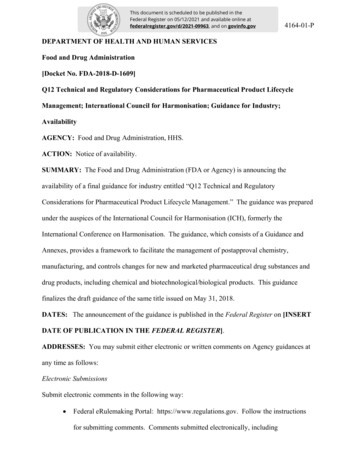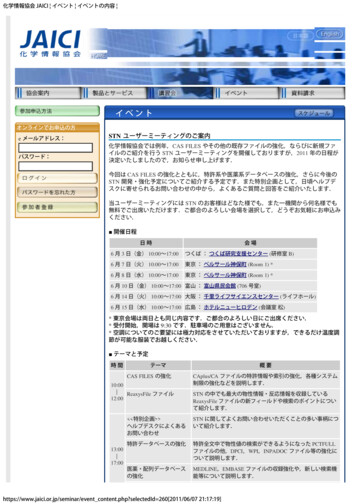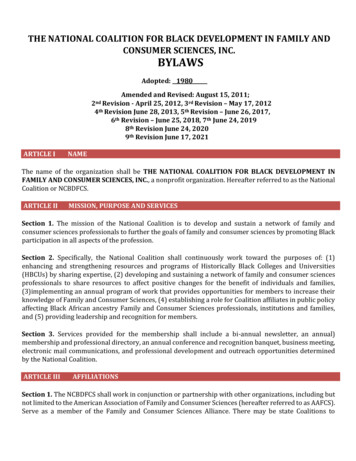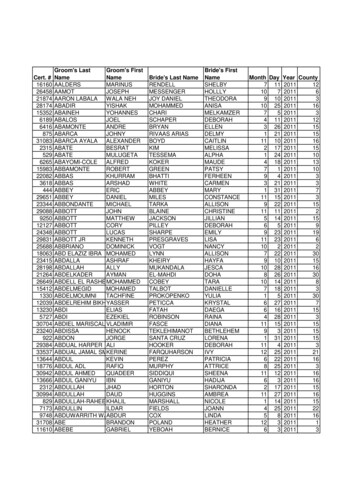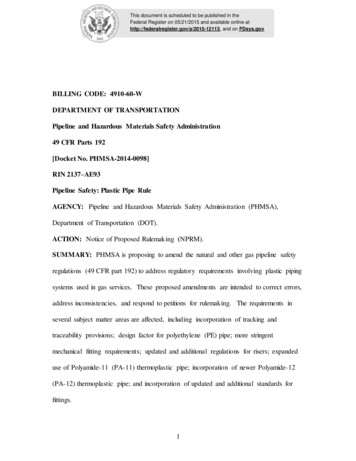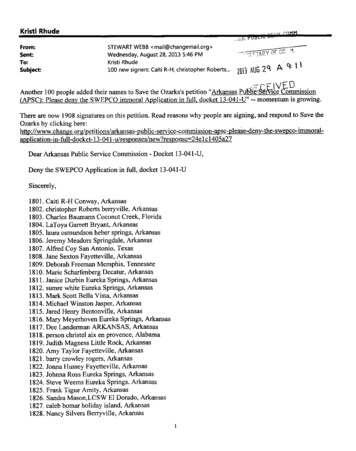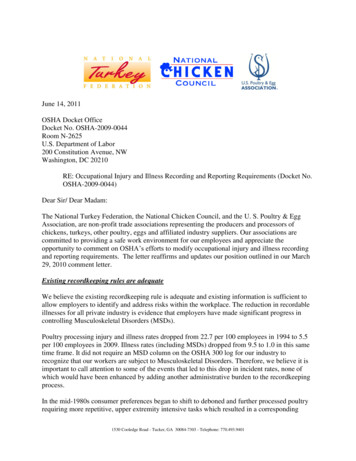
Transcription
June 14, 2011OSHA Docket OfficeDocket No. OSHA-2009-0044Room N-2625U.S. Department of Labor200 Constitution Avenue, NWWashington, DC 20210RE: Occupational Injury and Illness Recording and Reporting Requirements (Docket No.OSHA-2009-0044)Dear Sir/ Dear Madam:The National Turkey Federation, the National Chicken Council, and the U. S. Poultry & EggAssociation, are non-profit trade associations representing the producers and processors ofchickens, turkeys, other poultry, eggs and affiliated industry suppliers. Our associations arecommitted to providing a safe work environment for our employees and appreciate theopportunity to comment on OSHA‟s efforts to modify occupational injury and illness recordingand reporting requirements. The letter reaffirms and updates our position outlined in our March29, 2010 comment letter.Existing recordkeeping rules are adequateWe believe the existing recordkeeping rule is adequate and existing information is sufficient toallow employers to identify and address risks within the workplace. The reduction in recordableillnesses for all private industry is evidence that employers have made significant progress incontrolling Musculoskeletal Disorders (MSDs).Poultry processing injury and illness rates dropped from 22.7 per 100 employees in 1994 to 5.5per 100 employees in 2009. Illness rates (including MSDs) dropped from 9.5 to 1.0 in this sametime frame. It did not require an MSD column on the OSHA 300 log for our industry torecognize that our workers are subject to Musculoskeletal Disorders. Therefore, we believe it isimportant to call attention to some of the events that led to this drop in incident rates, none ofwhich would have been enhanced by adding another administrative burden to the recordkeepingprocess.In the mid-1980s consumer preferences began to shift to deboned and further processed poultryrequiring more repetitive, upper extremity intensive tasks which resulted in a corresponding1530 Cooledge Road - Tucker, GA 30084-7303 - Telephone: 770.493.9401
OSHA-2009-0044June 14, 2011Page 2increase in MSDs. The industry did not wait to see blocks checked on an OSHA recordkeepingform to understand that MSDs needed to be addressed. Increasing employee complaints ofdiscomfort, analysis of accident investigation reports, higher workers compensation expenses,increased employee turnover and reduced productivity were all indicators that this workplacehazard must be addressed. In response, a poultry industry task force of safety and medicalprofessionals developed a strategy incorporating medical intervention, ergonomics and trainingas key common denominators for successful preventative measures. These concepts werepublished in the “Medical-Ergonomics-Training Program: A Guide for the Poultry Industry”(1986). The stated goals of early medical intervention were to minimize employee pain andsuffering, maintain employee morale, maintain efficiency and production and minimize dollarlosses.Additional industry specific educational and training programs were implemented as new orrefined ergonomic solutions were developed. In 2004 the Georgia Tech Research Institute(GTRI), with funding from an OSHA Susan Harwood grant and the U.S. Poultry & EggAssociation, developed the “Ergonomics Course for the Poultry Industry”, a comprehensivetraining program for employees and supervisors. GTRI provided train-the-trainer courses basedon this curriculum which allowed dissemination of the information throughout the industry. Theprogram increased awareness of ergonomic risk factors and offered both engineering andadministrative controls to reduce MSDs in the workplace. Engineering controls includedimproved workplace design, automation, improved tool design and material handling equipmentand administrative controls included job rotation, job enlargement and work hardening programsfor new employees. These and similar initiatives have resulted in the outstanding reduction inworkplace MSDs incurred by the poultry industry over the past 25 years.Several OSHA publications have been helpful to the industry on addressing ergonomics. Thedocument “Guidelines for Poultry Processing Ergonomics for the Prevention ofMusculoskeletal Disorders” oultryprocessing/poultryprocessing.html)continues to be used by the industry. In addition the Poultry Processing Industry x.html) has been an effective program which hashelped reduce the number of recordable injuries.For these reasons, we believe the existing recordkeeping rules are adequate and adding the MSDcolumn in unnecessary.Definition of MSDWe propose that the definition be expanded to include (*):1904.12:(b) Implementation—(1) What is a „„musculoskeletal disorder‟‟ or MSD? MSDs aredisorders of the muscles, nerves, tendons, ligaments, joints, cartilage and spinal discs.MSDs DO NOT include disorders caused by slips, trips, falls, motor vehicle accidents, orother similar accidents. Such cases are not recordable. (*Occupational MSDs DO NOTinclude minor discomfort experienced by an employee during work hardening following
OSHA-2009-0044June 14, 2011Page 3new hire or transfer if the level of discomfort does not prevent the employee from beingfully able to perform all of his or her routine job functions. If the healthcare providerdetermines that the employee is fully able to perform all of his or her job functions, theemployer may assign a work restriction to that employee for the purpose of preventing amore serious condition from developing during the work hardening process). Examplesof MSDs include: Carpal tunnel syndrome, Rotator cuff syndrome, De Quervain‟sdisease, Trigger finger, Tarsal tunnel syndrome, Sciatica, Epicondylitis, Tendinitis,Raynaud‟s phenomenon, Carpet layers knee, Herniated spinal disc, and Low back pain.Recordkeeping Compliance Directive restricted work case exemptionThe notice of proposed rulemaking states that OSHA intends to remove the restricted work caseexemption language in the Recordkeeping Compliance Directive which currently states “minormusculoskeletal discomfort is not recordable under 1909.7(b)(4) as a restricted work case if ahealth care professional determines the employee is fully able to perform all of his or her routinejob functions, and the employer moves them for the purpose of preventing a more serious injury”(emphasis added).In the work hardening process, many employers in the poultry industry frequently followguidance from the health care provider and temporarily transfer new employees to other tasksuntil the employee develops the physical conditioning required to perform new job functions. Asoutlined in the current Compliance Directive, these job transfers are not recorded as injuries orillnesses.OSHA‟s comments on pages 4735-4736 of the Federal Register proposed rule notice suggest thatany condition requiring treatment that is first aid only does not meet the definition of arecordable injury and therefore assigning the employee to another task (i.e., during workhardening while only first aid measures are being taken) is not recordable. The Federal Registernotice references the preamble of the 2001 rule and states:“The agency rejected suggestions to add an exception to recordability for voluntary orpreventive job transfers. The agency explained that this concept is not relevant to therecordkeeping rule:Transfers or restrictions taken before the employee has experienced an injury orillness do not meet the first recording requirement of the recordkeeping rule, i.e.that a work-related injury or illness must have occurred for recording to beconsidered at all.”However, beginning at the bottom of page 4734 OSHA states:“ you must record a case as an MSD if (1) The employee experiences „„pain, tingling, burning,numbness or any other subjective symptom of an MSD;‟‟ (2) the symptoms are work-related; (3)new; and (4) meet the general recording criteria in the Recordkeeping regulation (e.g., restrictedwork, job transfer, days away from work, medical treatment beyond first aid)” (emphasisadded).
OSHA-2009-0044June 14, 2011Page 4This language appears to be in direct conflict with the position OSHA plans to use to supportremoving the current language in the Compliance Directive. It appears that the employer wouldbe required to record cases involving job transfer associated with a work hardening program ifthe transfer or restriction extends beyond the day the illness began, even if the healthcareprovider had made the determination that the employee could have fully performed all of his orher routine job functions.Work hardening programs allow employees to adjust to new physical demands which may beexpected to initially cause some level of discomfort, allow the employee to maintain goodmorale and a positive attitude toward a new job responsibility and reduce the potential forsubsequent, severe injury. We strongly urge OSHA to continue to allow employers to make thesetemporary job transfers and restrictions as part of the work hardening process. Recording suchevents as workplace illnesses will unnecessarily inflate the illness rates and do absolutelynothing to improve workplace safety. If anything, it may discourage some employers from takingproactive actions such as work hardening programs, ultimately resulting in more severe injuriesand illnesses in the work force.Days away from work casesOSHA expresses concerns that employers are recording fewer and fewer cases as days awayfrom work cases and references anecdotal reports “that employers are increasingly usingrestricted work, job transfers and medical treatment or surgeries without lost time to bringemployees back to work more quickly and to avoid recording MSDs as cases with days awayfrom work” (emphasis added).Workers compensation statutes require that full duty or modified duty return to work be subjectto the treating physician‟s orders so the decision on how quickly an injured employee may returnto work is not the employer‟s decision but the doctor‟s. Most employers and most workerscompensation professionals agree that early return to work is important and beneficial to theinjured employee. The Texas Department of Insurance Division of Workers‟ Compensationoutlines the following benefits of full duty or modified duty return to work for employees in itsbrochure “Making Return to Work-Work for Your Business and Your Employees”: Recovery time is shortened; Concerns about continued employment are eliminated; Loss of physical fitness due to inactivity is averted; Full or partial wages are earned bringing the injured employee‟s income closer to pre-injurywages; Retain job skills; Less likely to experience secondary complications such as depression that may delay orcomplicate recovery; Permanent disability associated with the injury is reduced; Maintain company benefits and seniority; Require less medical care and medication; Family and social lifestyles maintained; and
OSHA-2009-0044June 14, 2011Page 5The financial impact on the employee when away from work should not be underestimated. Allstate workers compensation statutes have waiting periods of between 3-7 days before lost wagebenefits commence and then lost wage benefits are generally limited to 2/3 of the employee‟spre-injury average weekly wage. Even with workers compensation insurance, days away fromwork result in lower paychecks for the employee so wherever applicable, aggressive return towork policies are beneficial to the employee. To suggest that employees are brought back towork more quickly “to avoid recording MSDs as cases with days away from work” is simplyinaccurate. Further, also inaccurate is the belief that employer practices regarding return to workpolicies may particularly affect MSD data. Return to work policies typically do not differentiatebetween MSDs and other types of injuries or illnesses because each return to work decision ismade by the treating physician based on the facts of that case.Thank you for the opportunity to comment. If you have any questions or require additionalinformation concerning our comments please do not hesitate to contact Paul Pressley of the U.S.Poultry & Egg Association at 770-493-9401, Stephen Pretanik of the National Chicken Councilat 202-296-2622, or Andrew Bailey of the National Turkey Federation at 202-898-0100.Sincerely,Joel BrandenbergerPresidentNational Turkey FederationMike BrownPresidentNational Chicken CouncilJohn StarkeyPresidentU.S. Poultry & Egg Association
refined ergonomic solutions were developed. In 2004 the Georgia Tech Research Institute (GTRI), with funding from an OSHA Susan Harwood grant and the U.S. Poultry & Egg Association, developed the "Ergonomics Course for the Poultry Industry", a comprehensive training program for employees and supervisors.



